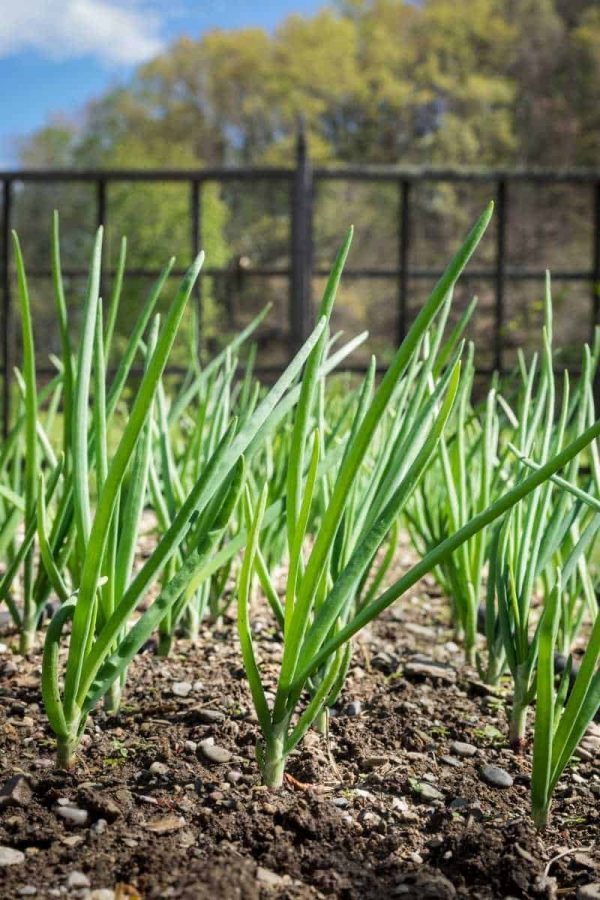Green onions are a simple addition to your garden that can add tons of flavor to your cooking. Green onions (AKA: scallions) are super easy for any gardener to grow because they take up so little space—just plop a green onion here and there between your other plants in your garden and you’ll be enjoying the fresh, oniony flavor on all kinds of meals!
Scallions are also great to use in the garden as companion plants—their strong scent can help mask scents and repel pests from nearby plants. Most plants in the onion family (like scallions) are relatively disease and pest-resistant on their own, making them incredibly easy to grow! Let’s get planting.

Table of Contents
What is the difference between green onions and scallions?
Most folks use the terms green onion and scallion interchangeably but in reality, they mean two different things.
Green onion is a broad term for any onion harvested before bulbing. They may be varieties of bulbing onions harvested before they have a chance to bulb, but green onions can also be varieties of onions that do not bulb.
Scallions are varieties that were bred to never grow a bulb. They have been specifically bred to have long, thin, white stalks before the start of their green leaves and are usually harvested young (AKA: green). You may see these listed in gardening catalogs as non-bulbing onions or bunching onions.
So basically, all scallions are green onions, but not all green onions are scallions. That being said, we’re going to use the terms interchangeably here, because both cover the final veggie we’re talking about and the growing conditions are the exact same.
Growfully Protip
What about spring onions? Spring onions are different types of onions from both green onions and scallions. Spring onions are often bulbing varieties of onions that are allowed to grow a small bulb. They’re harvested too late to be considered green onions but too early to be regarded as bulbing onions. They tend to be sweet and tender.

Are green onions easy to grow?
Yes! Even if you’re completely new to gardening, you can easily learn how to grow green onions. They’re extremely hardy and survive in a variety of conditions. Getting them started in the right soil will set you up for success throughout the entire growing season.
When should I plant green onions?
You can plant bulbing onion varieties as sets, seeds, or transplants, and there are specific planting dates related to bulb size and day length. Thankfully, you don’t grow green onions for the size of their bulb, so it’s a lot easier to navigate the best planting time for green onions.
Gardeners usually grow green onions from seed. For an early summer harvest, plant green onion seeds in late winter. For a later or secondary harvest in the fall, plant green onion seeds in mid-to-late summer.
Growfully Protip
Although gardeners often grow green onions from seed, you can also learn how to regrow onions from scraps. To regrow green onions, cut off the green part for use in your favorite recipes and leave roughly an inch of white above the roots. Place the roots in a cup with some water on a sunny window ledge and watch your green onion grow over the next few days! Once it has sprouted about an inch of new growth, transfer it to a pot with soil to keep the growing going.

Where should I plant green onions?
Green onions prefer a site that’s in full sun. Choose a location that has well-draining soil. It’s better to grow green onions in sandy soil rather than clay.
Green onions don’t require the same level of nutrients that their larger, bulb onion counterparts do. However, you still need to ensure that you work well-rotten manure, compost, or fertilizer into the soil before planting onion or scallion seeds. Adding some nutrients at the beginning of the growing season will help you avoid needing to add nutrients partway through the season.
If you’re short on garden space, consider planting green onions between parsnips or carrots. Parsnips are slower growing, and you’ll harvest your green onions before the parsnips need the extra room. Growing green onions between carrot plants is also a great way to cut down on carrot rust flies.
Growfully Protip
Consider succession planting green onions every four weeks for a steady supply of this fresh vegetable. In milder climates, you can even plant a cold-hardy variety in late fall to overwinter and provide you with early spring green onions the next year!
How to sow green onion seeds
Sow green onions directly in your garden or container in early spring. You can either sow seeds in rows or broadcast the seed over an area in your garden. Whichever method you choose, make sure you lightly rake the area where you’ll be planting green onions before sowing seeds.
- To sow green onion seeds in rows, dig a small trench ½ inch deep. Sow seeds ½ inch apart and make sure rows are at least four inches apart from one another. Backfill the trench and water well.
- To broadcast green onion seeds, lightly dig out a ½ inch deep band about three inches wide. Use your fingers to sprinkle seeds along this band, distributing them as evenly as possible. Cover the seeds carefully with soil and water well.
Growfully Protip
If your soil is very sandy or conditions are dry and warm, water your trench before you sow the seeds to provide a moist, cool environment for your green onions to germinate.
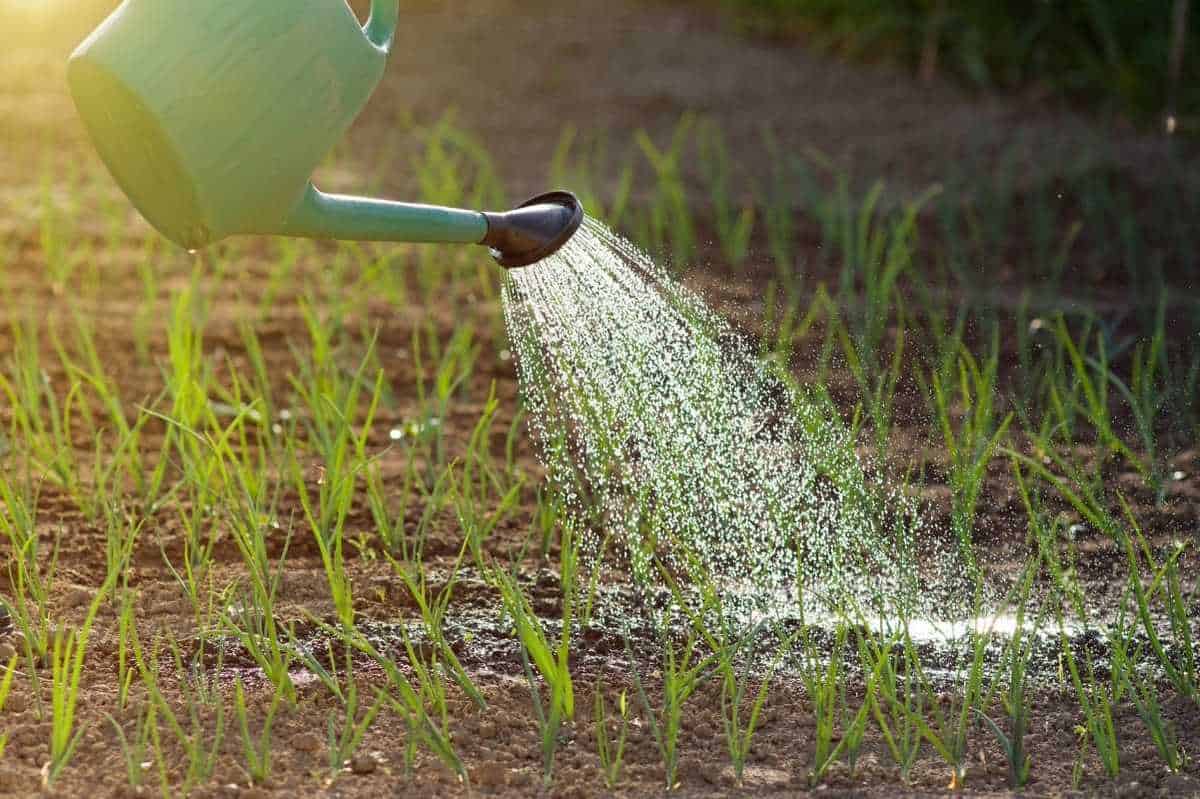
How to transplant green onion seedlings
If you live in a cooler climate and you want to get a head start on the growing season, you may decide to start your green onion seeds indoors. Some garden centers also sell green onion transplants that you can plant outdoors for a faster harvest.
To start your own green onion seedlings, fill plug trays with a good quality potting soil or seed starting mix. Plant three to four seeds per plug and water well. You can do this up to six weeks before you plan to transplant them outside.
To transplant green onion seedlings, take the whole plug and gently remove the batch of seedlings, taking care not to break off any of the fragile roots. Plant the whole grouping of seedlings in a hole as deep as the plug transplant. Space green onion transplants two to four inches apart in rows four inches apart. Water the seedlings well to help them get settled in their new environment.
Growfully Protip
We rarely grow specific scallion varieties for green onions. Instead, we plant extra of our main crop of onions (either from starts or sets). We space our main crop of onions out about 2-3″ apart. And then when the onions are big enough to be green onion size, we harvest every other one. That means we get green onions for our salads and we thin out the rows to be large enough for the remaining onions to bulb properly. We love the idea of getting two crops with one planting!
Can you grow green onions in a pot?
Green onions are well suited to containers since they take up very little space and you can plant them close together. You don’t have to worry about the depth of the container since they have shallow roots—anything around 6″ deep will do. However, check that your container has good drainage, as green onions don’t like having wet feet.
To grow green onions in a container, fill it with good quality potting soil and poke holes ½-inch deep spaced one inch from one another. Sow seeds in the holes, backfill with potting soil, and water well. Green onions planted in containers will need more water throughout the growing season than those direct sown in garden beds, so keep an eye out for dry soil.

How to grow green onions indoors
Green onions are one of those crops that need to be eaten fresh, and the growing season is only so long. Thankfully, you don’t have to give up your crisp, fresh, green onions when winter rolls around. Green onions take up very little space, so you can easily grow them indoors no matter the season!
Choose a container with good drainage and fill it with good quality potting soil. Plant seeds ½-inch deep and leave 2-3 inches between each plant. Water the seeds well, and you’ll see germination in roughly seven to ten days. Choose a bright location for your green onions, such as a sunny windowsill or under a grow light.
Growing green onions indoors is a simple way to ensure a steady supply of these tasty little onions to toss in soups, use on salads, or use as a garnish throughout the year.
Helping green onion plants thrive
Once green onions have sprouted, they’re fairly low-maintenance. As long as you worked some well-rotted manure or compost into the soil prior to planting, you shouldn’t have to fertilize your green onions during the growing season.
You may need to thin your green onions, especially if you used the broadcast method of sowing. To do this, cut the green onion near the base so you don’t disturb the shallow root systems. Thin any large clumps of green onions so there’s a half-inch between plants. Don’t toss out those thinnings! Use them like chives on an omelet for breakfast.
Weeding is very important for growing green onions because weeds can quickly overwhelm your thin plants. Weed early and thoroughly to prevent weeds from getting well established and difficult to remove. A layer of good mulch, such as straw or pine shavings, will help with both weed suppression and moisture retention.
Green onions (like all onion family plants) have shallow roots, which means they require regular watering, especially when the weather is hot and dry. When the top inch or so of your soil has dried out, it’s time to water.
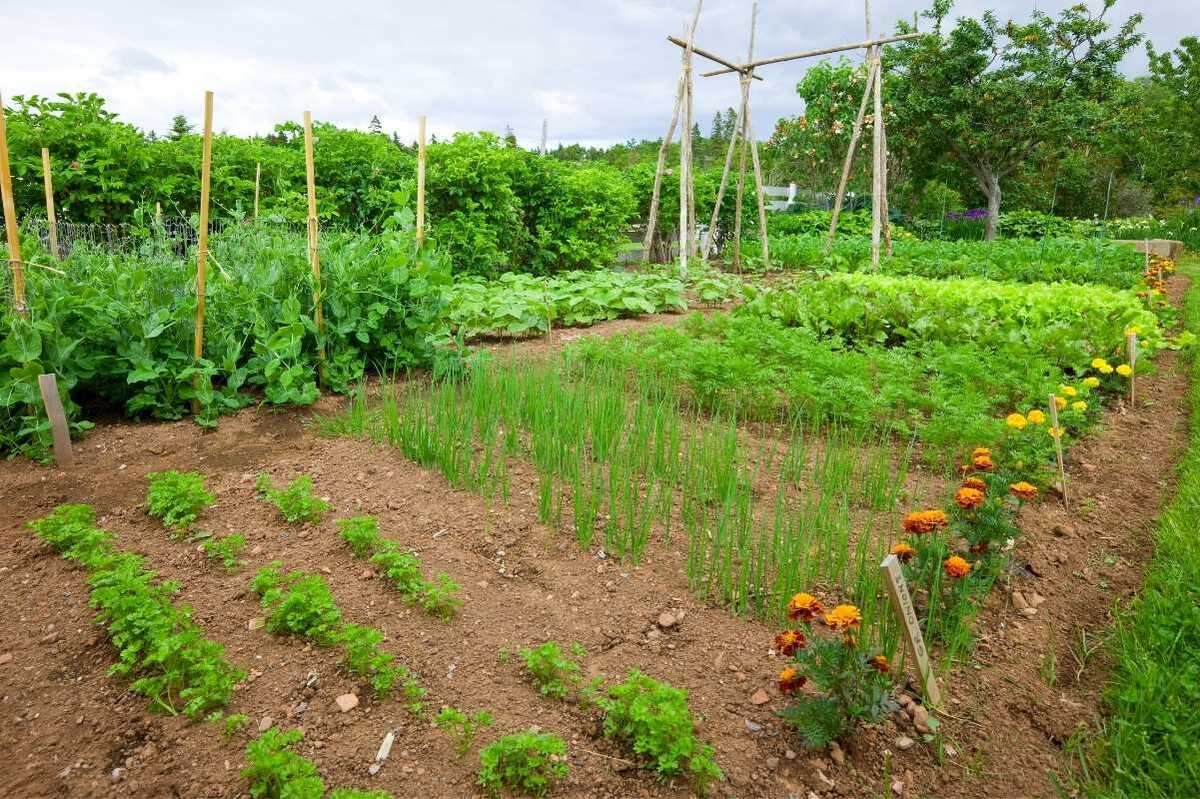
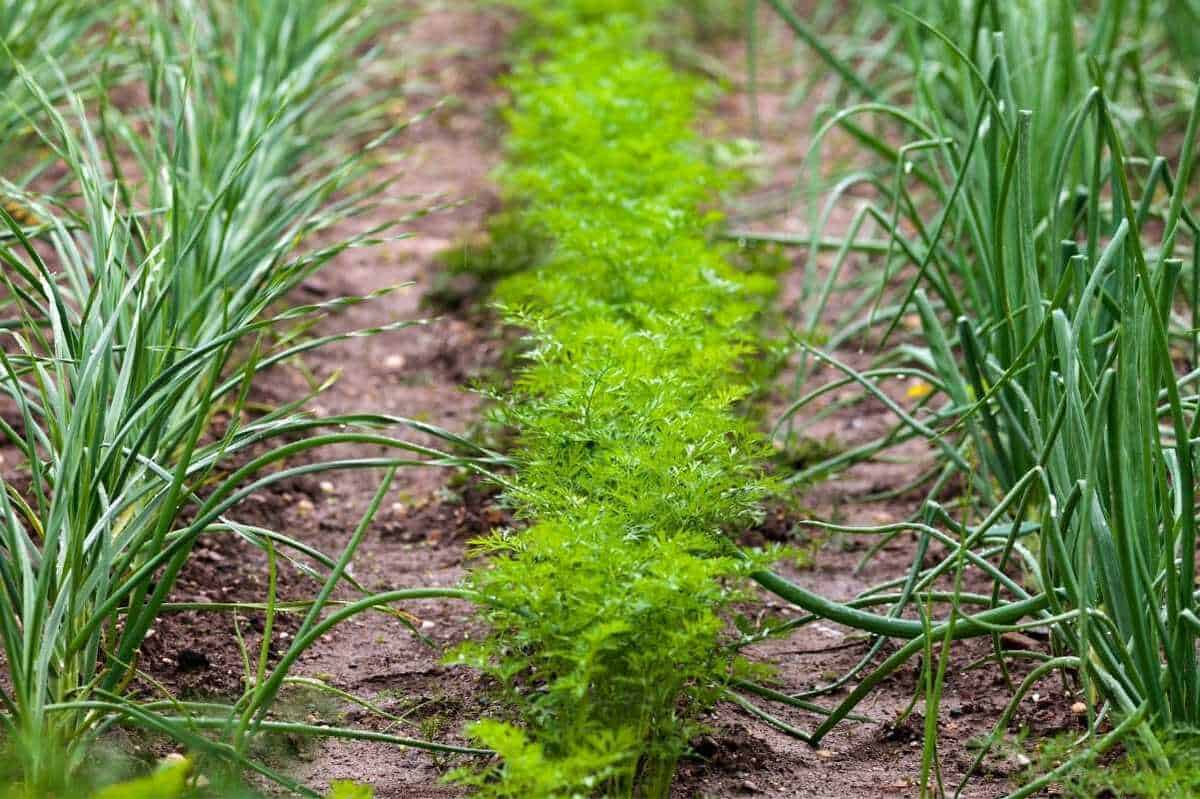
Companion planting
Green onions are great companions for many different plants in the garden. They share many of the same companions as bulbing onions since they’re part of the same family. Their potent scent helps deter pests such as carrot rust flies, aphids, flea beetles, and even rabbits!
Their shallow root system and thin growing habit also makes them great companions for many plants because they don’t compete for space or nutrients. The following are some of the best companion plants for green onions.
- Carrots—Green onions help repel carrot rust flies.
- Tomatoes—The aromatic scent of green onions will help repel pests from your tomatoes.
- Peppers—Aphids that could target pepper plants are repelled by the scent of green onions.
- Beets—Green onions fit nicely between beet plants and help repel both large pests, such as rabbits, and smaller ones, such as aphids and flea beetles.
- Melons—Again, the scent of green onions helps repel pests that can harm melons.
- Brassicas—Green onions can protect Brussels sprouts, broccoli, kale, kohlrabi, cabbage, and cauliflower from cabbage maggots, cabbage worms, cabbage loopers, and flea beetles.
- Herbs such as summer savory and chamomile—These herbs both help attract beneficial insects that may harm green onions.
- Strawberries—Green onions help repel aphids away from strawberry plants.
Although green onions play nicely with most plants, avoid planting them near beans, asparagus, and other members of the onion family. Asparagus will compete for nutrients with green onions, while all onion family members (including garlic) attract the same pests. Green onions can strip the beneficial bacteria from bean plants, so it’s best to keep these two separate as well.
Growfully Protip
Because of scallions’ small size and impressive pest repellant powers, we recommend sticking them in any small open space in your garden!
How long after planting does it take to get green onions?
If you planted green onions in cool spring weather, you can expect to harvest them within ten to twelve weeks of sowing your seeds. Planting them in warmer weather might speed up your harvest time to as little as eight weeks after sowing. Green onions are one of those plants that you can harvest at any time—just harvest whenever the scallion is big enough for you to use.
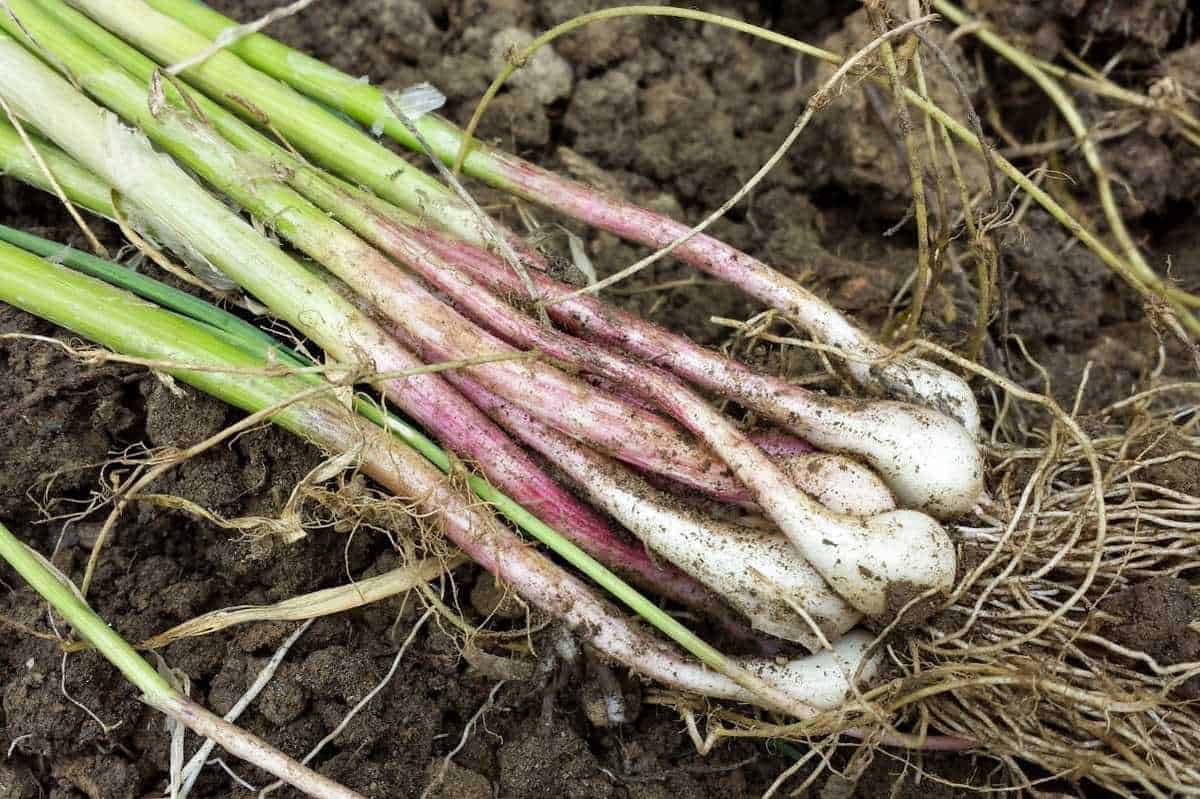
When do I harvest green onions?
You can harvest green onions as soon as their leaves reach a size that works for you to use. Most folks typically wait until the leaves are about the diameter of a pencil. This can take anywhere from eight to twelve weeks. Make sure to harvest the largest green onions first to allow the smaller ones to continue to grow.
Growfully Protip
The earlier you harvest green onions, the smaller they are, and the milder the flavor will be. The longer you leave them—and the larger they grow—the more intense their flavor will be. This makes the ideal harvesting time a matter of personal preference.
Pests and diseases
Green onions are very hardy, and there aren’t many pests or diseases you need to be concerned with. Most of the diseases that affect other members of the onion family attack the bulb of the onion. Since you don’t grow green onions for the bulbs, these diseases aren’t of as much concern. Proper companion planting, weeding, and watering will help keep green onion plants healthy and strong. There are, however, some common pests and diseases to be aware of.
- Allium leaf miners—Little flies that lay their eggs on the leaves of onion plants. The larvae that hatch will eat their way up and down the leaves, leaving a white trail and killing off the plant. You can prevent allium leaf miners by covering your green onions with floating row covers.
- Thrips—Small insects that attack the leaves of your green onion plants. They leave behind blotchy streaks and can cause deformed leaves of your green onions. Hosing your plants down with a soap and water solution is a good way to manage these pests.
- White rot—As the name suggests, this disease is a white-colored rot that can affect every member of the onion family. It starts at the base of the onion, and it can kill off entire plants. It’s worth noting that this disease can live in the soil for up to 20 years. Proper crop rotation is important for prevention.
- Downy mildew—Fuzzy mildew that covers the leaves of green onion plants, causing them to turn yellow before collapsing. Be sure to plant green onions in soil that drains well to discourage downy mildew. Proper crop rotation and good air circulation are also important in preventing this disease.
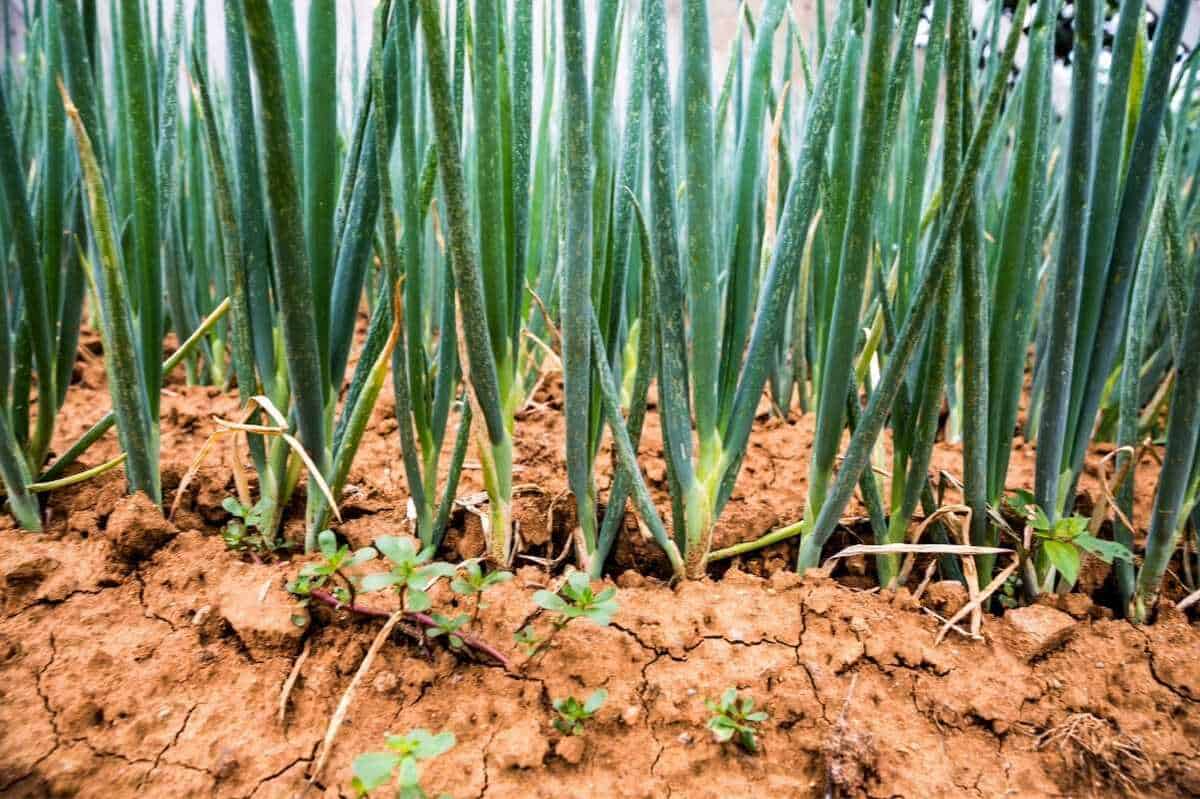
How to harvest and store green onions
There are two methods for harvesting green onions. You can harvest the leaves, so the plant continues growing, or you can harvest the whole plant.
- To harvest the leaves, snip off about a third of the plants’ green tops. You can think of it as giving your green onions a haircut. The plant will continue to grow, allowing for multiple harvests.
- To harvest the whole plant, gently loosen the dirt around the base of the plant using your fingers, then pull it from the ground. Brush away any loose dirt, and use a sharp knife to cut off the roots.
There are a few different options for green onion storage.
- To store green onions in the fridge, wipe away any visible dirt and wrap them in a damp paper towel or terrycloth storage bag. Place the wrapped scallions in the fridge for up to a week. Alternatively, put the bottoms of the green onions in a glass jar of water like you would a bouquet. Store them on a sunny windowsill to grow more onions, or put them in the refrigerator for up to one week.
- To freeze green onions, wash them well and slice into rings ½ inch or smaller. Freeze them on a baking sheet until solid, then toss the cut green onions in a container or bottle to store long term in the freezer.
- To dry green onions, wash and slice them into pieces. Use a dehydrator at the recommended setting or place them in the oven set to the lowest possible temperature. Keep an eye on your green onions and remove them when they become brittle and crispy. Store in a glass jar so they’ll last for years.

How to Grow Green Onions
Materials
- Onion seeds
Instructions
- No fertilizer required. As long as you amend the soil with compost before planting, you shouldn't need to fertilize green onions during the growing season.
- Thin and weed carefully. To thin plants or weed the bed, use clips to cut them at the soil line. Green onion roots are shallow and can be uprooted when you pull seedlings or weeds from the soil.
- Use mulch. A layer of mulch will help suppress weeds and retain moisture in the soil.
- Water regularly. Water whenever the top inch or so of soil is feeling dry.
- Use for companion planting. Green onions are great companions for many vegetable plants, as their strong scent repels pests.

